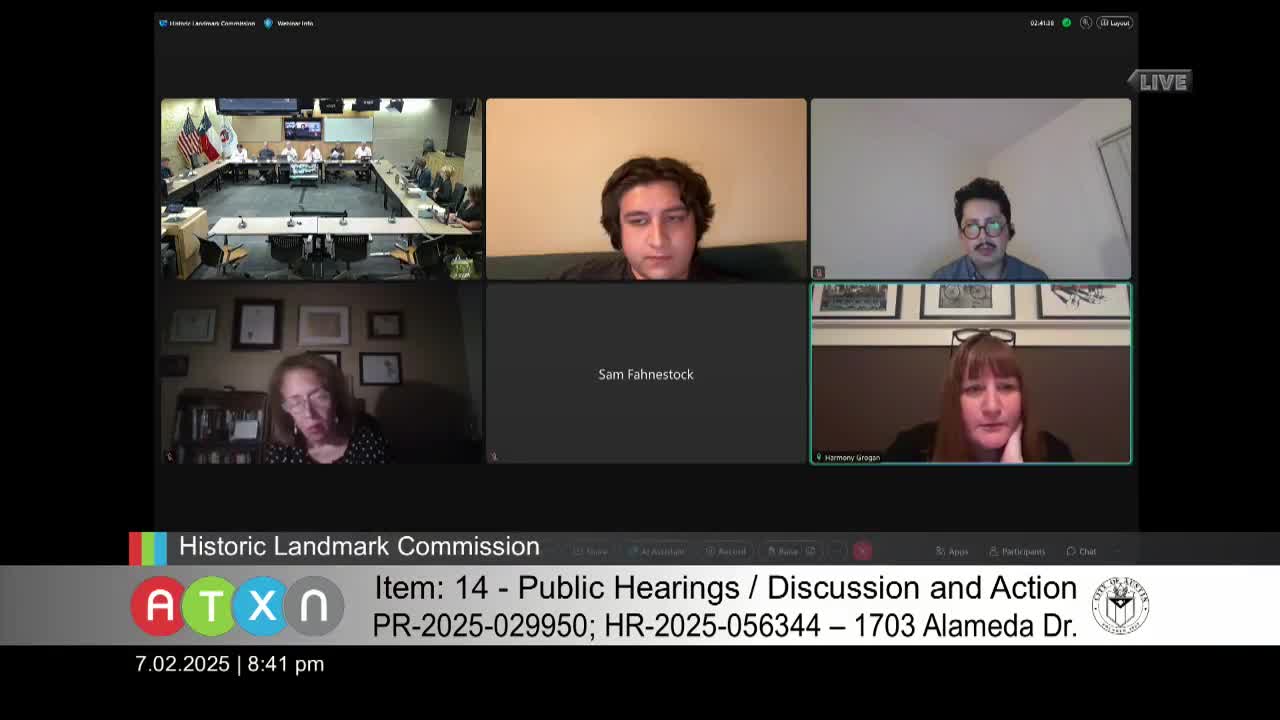Hancock Neighborhood Association opposes demolition of historic duplex at East 30 Eighth Street
July 02, 2025 | Austin, Travis County, Texas
This article was created by AI summarizing key points discussed. AI makes mistakes, so for full details and context, please refer to the video of the full meeting. Please report any errors so we can fix them. Report an error »

In a recent meeting of the Austin Landmark Commission, significant discussions centered around the preservation of historic properties in the city, particularly focusing on two notable cases: a proposed garage design and the potential demolition of a 1935 duplex.
The commission addressed the design of a garage within a National Register District, emphasizing the importance of maintaining the area's architectural integrity. Commissioners expressed appreciation for the applicants' willingness to engage in constructive dialogue about the design, which aims to respect the scale and character of existing structures. The commission voted to postpone further discussions until their August meeting, allowing for additional input from the Architectural Review Committee.
Another key topic was the proposed demolition of a duplex located at 607 East 38th Street. The property, which has historical significance due to its original construction as a duplex during the Great Depression, has drawn opposition from local residents. Charles Darkord, president of the Hancock Neighborhood Association, urged the commission to postpone the demolition to allow for further negotiations with the property owners. He highlighted the potential for development that preserves the existing structure, which contributes to the neighborhood's character.
Residents voiced concerns that the demolition could lead to a loss of historic architecture in the area. Barbara Epstein, a nearby neighbor, stressed the importance of the duplex's architectural style and its role in maintaining the neighborhood's historic integrity. She warned that approving the demolition could set a precedent for further demolitions, threatening the area's historic fabric.
The commission ultimately decided to release the demolition permit contingent upon the completion of a documentation package, which will provide a record of the property's historical significance. This decision reflects a commitment to balancing development needs with the preservation of Austin's rich architectural heritage.
As the commission prepares for its next meeting, community members remain engaged, advocating for the protection of their historic neighborhoods while navigating the challenges of urban development. The outcomes of these discussions will play a crucial role in shaping the future of Austin's historic districts.
The commission addressed the design of a garage within a National Register District, emphasizing the importance of maintaining the area's architectural integrity. Commissioners expressed appreciation for the applicants' willingness to engage in constructive dialogue about the design, which aims to respect the scale and character of existing structures. The commission voted to postpone further discussions until their August meeting, allowing for additional input from the Architectural Review Committee.
Another key topic was the proposed demolition of a duplex located at 607 East 38th Street. The property, which has historical significance due to its original construction as a duplex during the Great Depression, has drawn opposition from local residents. Charles Darkord, president of the Hancock Neighborhood Association, urged the commission to postpone the demolition to allow for further negotiations with the property owners. He highlighted the potential for development that preserves the existing structure, which contributes to the neighborhood's character.
Residents voiced concerns that the demolition could lead to a loss of historic architecture in the area. Barbara Epstein, a nearby neighbor, stressed the importance of the duplex's architectural style and its role in maintaining the neighborhood's historic integrity. She warned that approving the demolition could set a precedent for further demolitions, threatening the area's historic fabric.
The commission ultimately decided to release the demolition permit contingent upon the completion of a documentation package, which will provide a record of the property's historical significance. This decision reflects a commitment to balancing development needs with the preservation of Austin's rich architectural heritage.
As the commission prepares for its next meeting, community members remain engaged, advocating for the protection of their historic neighborhoods while navigating the challenges of urban development. The outcomes of these discussions will play a crucial role in shaping the future of Austin's historic districts.
View full meeting
This article is based on a recent meeting—watch the full video and explore the complete transcript for deeper insights into the discussion.
View full meeting
